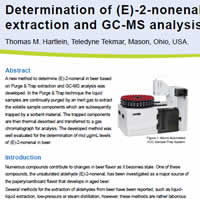Resumo do Pôster:
1. Introduction
Numerous compounds contribute to changes in beer flavor as it becomes stale. One of these compounds, the unsaturated aldehyde (E)-2-nonenal, has been investigated as a major source of the papery/cardboard flavor that develops in aged beer. Several methods for the extraction of aldehydes from beer have been reported, such as liquid-liquid extraction, low-pressure or steam distillation, however, these methods are rather laborious and prone of errors. As chromatographic signals of trace components may be masked by high concentrations of major components, the majority of the procedures involve preconcentration followed by a derivatization step and separation by HPLC or GC, but derivatization of the carbonyls is an additional step to complicate the analysis.1
This work presents a new method to determine (E)-2-nonenal in beer based on Purge & Trap extraction and GC-MS analysis. Purge & Trap, also known as dynamic headspace, is a technique of extraction and concentration which principle is to pass an inert, pure gas through a (heated) closed purging vessel whereby the volatile organic compounds (VOCs) are driven from the sample. The expelled volatile compounds are transported with the gas to an adsorbing material in a trap. After the step of adsorption, the trap is heated and the components are thermal desorbed and transferred by the carrier gas to the capillary column in the GC where the components are separated and detected. Purge & Trap is ideal for dirty samples, solid materials, and samples with high boiling point analytes of no interest, high water content, analytes too low in concentration, and samples that are difficult to handle by conventional GC.
2. Purpose
Demonstrate the use of Purge & Trap method to adequately extract (E)-2-nonenal from beer and transfer it to a GC-MS system for quantification.
3. Method
An automated VOC sample prep system that combines an autosampler and Purge and Trap into a single instrument was used to extract and concentrate (E)-2-Nonenal from samples of beer. Tenax was used as adsorbent material in the trap. Some parameters of the Purge & Trap method are presented in Table 1.
Table1. Purge & Trap parameters |
Purge Time |
10 min |
Purge Flow |
25 mL/min |
Purge Temp |
70 °C |
Desorb Preheat Temp |
220 °C |
Desorb Temp |
225 °C |
Five lots of a commercial pale lager beer were analysed. Aliquots of 10 mL were sampled, degassed, and added with 6 g NaCl to improve the extraction by the salting out effect. Solutions with 0.27 to 5.4 ppb of (E)-2-Nonenal in 5% (v/v) ethanol were prepared for calibration. The analyses were done in a GC-quadrupoleMS system in the Selected Ion Monitoring (SIM) mode. The capillary column was a Rtx®-VMS, 20 m x 0.18 mm ID x 1 m. The oven program was: 95 °C, 3.5 °C/min to 145 °C, 15 °C/min to 240 °C, 3 min final hold, 21.7 min Run.
4. Results and Discussion
Figure 1 presents the SIM Total Ion Chromatograms of a beer sample in triplicate, and the overlap of a sample spiked with (E)-2-Nonenal. The concentrations of (E)-2-nonenal determined in five lots of a commercial pale lager beer are presented in Table 2.
5. Conclusion
The initial results presented in this work suggest that the Purge & Trap extraction technique coupled to GC-MS analysis is an adequate new method to determine mid µg/mL levels of (E)-2-nonenal in beer. A validation study has yet to be developed with this method.
6. Reference
- Scherer, R.; Wagner, R.; Kowalski, C.H.; Godoy, H. T. (E)-2-Nonenal Determination in Brazilian Beers using Headspace Solid-Phase Microextraction and Gas Chromatographic Coupled Mass spectrometry (HS-SPME-GC-MS). Ciência e Tecnologia de Alimentos, Campinas, 30(Supl.1): 161-165, Maio 2010.
|

